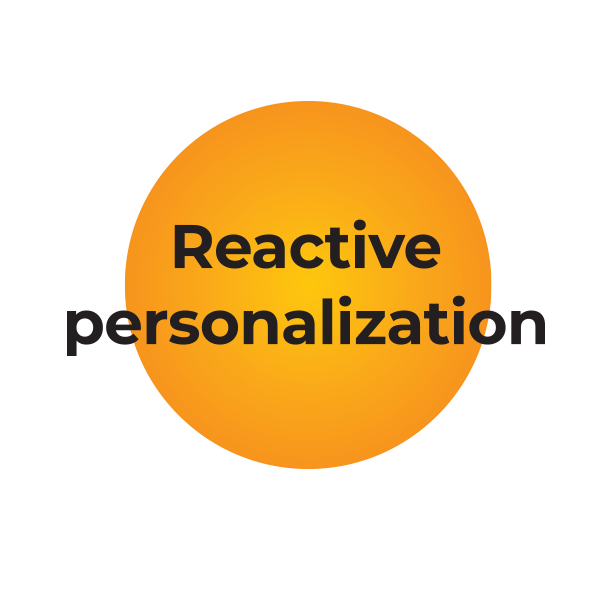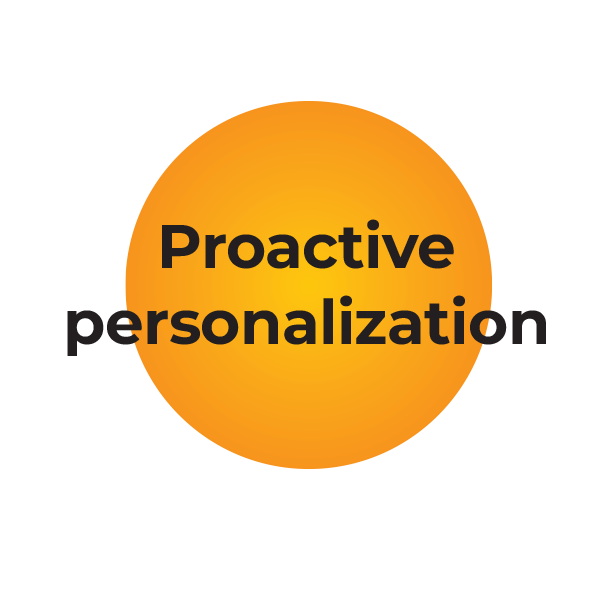Customers who completed a McKinsey survey equated “personalization” with “positive experiences that made them feel special.”1 Today’s customers expect relevant messages that speak directly to their unique interests and solve their pain points. And marketers now have the tools to collect detailed insights about their customers, enabling them to create personalized marketing campaigns that can:
- Reduce customer acquisition costs by up to 50 percent
- Lift revenues by 5 to 15 percent
- Increase marketing ROI by 10 to 30 percent
Here’s a look at the levels of personalization in content strategy, with examples included.

Reactive personalization is derived from personal and demographic information (such as a customer’s name, preferences, and location) and event data (a customer’s interactions with a brand). It’s a one-to-many approach that is applicable to large audience segments. Reactive personalization is easy to implement by using customer attributes like first name, event milestones like birthdays, or customer actions like cart abandonment. Other examples include:
• Personalized product recommendations:
These are based on products that other customers who purchased that same item have bought.
• Geolocation targeting:
Customers can be enticed to act in real time by sending them a push notification via SMS or email based on where they’re currently located to alert them of a sale or product availability nearby.
Reactive personalization is a good first step, but it may fall short of delivering a truly special customer experience. The next level of personalization makes a leap from “reacting” to “anticipating.”
Proactive personalization allows marketers to prepare and deliver relevant content before customers realize they want it. This one-to-some approach is applicable to smaller, targeted segments. It uses zero-party data voluntarily provided by customers through tactics such as preference surveys or interactive polls. This becomes an equitable value exchange: customers receive a benefit, such as product recommendations based on their preferences, while marketers build trust with their audience. Examples of proactive personalization include:
• Automatic booking:
If an airline customer misses a connecting flight because of a delay, the right systems can get them booked on the next flight out and authorize a flight attendant to offer extra points on their frequent flyer account.
• Dynamic content blocks:
Proactive email marketing utilizes content that changes based on user preferences. “Send” times are optimized by time zone so that messages reach customers when they’re most likely to engage.
Proactive personalization presses a lot of the right buttons for today’s audiences. But the ultimate level of personalization goes even further.


We’re a long way from “Dear Sheila” now. Hyper-personalization is a one-to-one approach in which every interaction and piece of content is personalized to a specific individual. It involves the use of real-time data, artificial intelligence, and predictive analytics. A customer’s every click, search, and purchase is analyzed, revealing preferences and behaviors.
The goal is for each audience member to experience a journey that is unique to them. Examples include:
• Recommendation engines:
By analyzing customers’ past purchases, browsing history, and interactions with the platform, Amazon and Netflix can make highly personalized recommendations for products or content that align with each customer’s interests.
• Personalized retargeting ads:
Retargeting ads use data from a customer’s online behavior to show them relevant ads as they browse the web. With hyper-personalization, these ads can be tailored even further based on individual preferences and interests.
A hyper-personalization campaign can deliver the highly individualized experiences that customers crave and make them more likely to engage and convert. When implemented ethically and transparently, it can also improve customer trust and loyalty.
The bottom line on personalization — at any level — is that it’s essential for your marketing strategy. When it’s done right, you’ll connect with your audience, enhance brand reputation, satisfy customers, and increase revenue.
